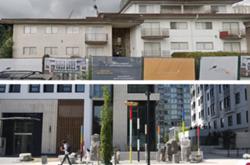Canada’s meagre social and affordable housing stock is dwindling, a recent Canada Mortgage and Housing Corp. survey shows.
Unlike market housing, which is vulnerable to the whims of real estate speculators or the self-interest of shareholders, non-market housing can offer tenants an oasis of stability where rents increase on par with incomes.
Following provincial trends, major cities across the country, including Vancouver and Montreal, have lost thousands of non-market rental units over the last three years.
Though Alberta recorded a humble bump of 380 units, Calgary has lost more than 1,500 non-market rental units since 2021.
This is concerning to advocates, in particular because Calgary’s share of non-market rental housing is one of the lowest in the country.
“I’m horrified at that number,” says Meaghon Reid, executive director of Vibrant Communities Calgary, a poverty reduction organization. “Calgary is always at the top three of the highest wealth inequity in the country. That means that people who are at the bottom of that inequity are really not doing well.”
Though Reid is horrified, she’s not surprised.
“We do know that there’s a lot of units that have fallen into extreme disrepair to the point that we can’t live in them,” Reid says.
“The fact that we build and don’t think about [what it’s] going to cost to maintain that asset means that we’re always starting from the beginning again, and that’s so sad in this current crisis.”
Where are the units going, and why?
According to CMHC, the disappearance of these units could be due to statistical adjustments, demolition or reclassification of units.
But because the City of Calgary doesn’t have current data on the number of non-market units owned by non-profit organizations, and the province did not respond to The Tyee’s request for comment by the time of publication, the precise whereabouts of the 1,574 non-market units no longer recorded in Calgary’s social and affordable housing universe remains uncertain.
The survey’s data, however, shows a concerning pattern.
Considering that 80 per cent of the units lost are owned by a non-profit housing provider, and that roughly three out of five of the units lost since 2022 were at least 35 years old, the limited availability of maintenance funds for Alberta non-profits could bear at least part of the blame for the loss of social and affordable housing in Calgary.
Kyle Fawcett, chief external relations officer at Silvera for Seniors, a non-profit housing provider in Calgary, says that insufficient government funding for operations and maintenance can be a barrier to preventing the loss of existing units.
“The amount of capital grants needs to be sufficient to support and maintain operations in the building, or else you’re running at a deficit,” he says. “The biggest thing is accessing suitable and sufficient capital funding across all orders of government.”
Currently, the federal government runs one program that offers community housing organizations up to $50,000 per project to preserve existing housing.
For its part, the Alberta government funds only maintenance for units owned by the province. Predictably, for a conservative government, Alberta has been seeking to offload its publicly owned stock to non-profits.
Disrepair isn’t the only cause for the loss of non-market units.
Because roughly a third of the vanished units have been constructed since 2004, according to CMHC’s survey, funding agreements coming to an end could also be eroding Calgary’s non-market stock, as the handful of federal programs for affordable housing created since the early 2000s have significantly decreased requirements for long-term affordability.
Prior to the 1980s, 35-to-50-year agreements were commonplace. But federal programs such as the Affordable Housing Initiative, launched in 2001, required a minimum of only 10 years of affordability. The Affordable Housing Initiative program funded the creation of 3,683 affordable units in Alberta.
Today, programs such as the Rapid Housing Initiative and Alberta’s Affordable Housing Partnership Program require funding recipients to maintain rents at below market rates for a minimum of 20 years.
When an agreement ends, non-profits have the option to move the released units to the mainstream rental market and use the revenue from this change to fund the operation and maintenance of the remaining non-market units, reducing their dependency on government funding.
“The whole idea of mixed-market strategies is that either on a portfolio or building basis, market units can generate revenue to help support less revenue being generated in affordable units,” Fawcett says, noting that revenues from market units can also help non-profits grow their non-market portfolio.
Since 2021, Silvera has transitioned 20 non-market units to market rates and increased its non-market stock by 26 per cent. However, new construction doesn’t always happen quickly enough to offset the loss of non-market units, as non-profits have to stitch together funding from a range of programs and sources.
“Typically, the funding programs delivered by the different levels of government aren’t aligned, and that makes it challenging,” Fawcett says.
Despite the addition of 190 units to Calgary’s social and affordable housing stock since 2021, Calgary has seen a net loss of 1,384 units.
“I believe governments are still challenged to find the right balance about how much affordable housing units need to be funded in a way that also allows market housing to help subsidize operations,” Fawcett says. “The question also becomes, how much market housing do you need?”
Building more non-market housing
Research suggests that adding supply at any point of the housing continuum improves affordability across the spectrum, but even when non-market units aren’t lost to disrepair and remain in the rental universe, market rentals are out of reach for the 104,330 Calgarians already spending more than a third of their income on rent.
“Adding supply of every kind is the way to help release pressure on the housing market and reduce costs,” Reid says. “But that’s one of many important elements. If we’re looking at the needs of people who live in low-income, or who are in core housing need, we do need to make sure that we are adding to the non-market supply specifically, because the rent differential on a non-market unit versus a market unit is significant.”
The average rental rate of the social and affordable units included in CMHC’s survey is $519, or less than a third of the average rent for market units. According to the University of British Columbia’s Housing Assessment Resource Tools, in 2021 the housing deficit for low- and very low-income households in Calgary was close to 45,000 units.
To facilitate the production of an additional 3,000 non-market housing units per year between 2024 and 2030, the City of Calgary plans to sell city-owned land to housing providers at a low cost, streamline the process to access this land, and bolster the organizational capacity of non-profit organizations.
“The resources that the city stewards are primarily land and regulations,” says Ward 8 Coun. Courtney Walcott. “While we may not be the order of government that will foot the bill for keeping provincial or non-profit units open, you can be sure the city won’t be a barrier to them doing so.”
Although the commitment to affordability required by the city’s evaluation criteria for non-market housing land sales is 40 years, preventing the loss of units owned by the non-profit sector is a responsibility of senior levels of government, not the city.
“We can protect our own units,” Walcott says. “But the city just doesn’t have the capacity to protect units owned by non-profits.”
To ensure the sustained well-being of lower-income Calgarians, Reid believes governments should anticipate the loss of non-market housing.
“We can’t fix what we don’t measure,” Reid says, pointing at the need to improve data collection and forecasting on housing affordability.
“I don’t think most cities understand the type of mix of affordable housing that they have. It’s clear to me, in this housing crisis, that we did not forecast appropriately in this country — we really missed the mark.” ![]()

















Tyee Commenting Guidelines
Comments that violate guidelines risk being deleted, and violations may result in a temporary or permanent user ban. Maintain the spirit of good conversation to stay in the discussion and be patient with moderators. Comments are reviewed regularly but not in real time.
Do:
Do not: